From the Manual of
Inga Agroforestry
by Dr. Guillermo Valle, CURLA, Honduras.
Inga Alley Cropping Manual
Introduction
In general,
smallholder farmers on slopes face many problems. They have to make a
living on landscapes of 30 % or more of incline, with shallow soils,
rampant deforestation (due to slash and burn agriculture), high risk of
erosion and landslides, loss of biodiversity and water, as well as
using an agricultural system that is highly extractive and ends in soil
degradation.
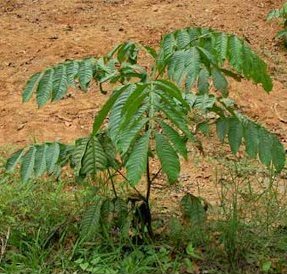
Fig.
1. Young Inga tree.
The genus Inga
is inclusive of around 300 species, which are widely distributed, and
very commonplace in low and highland areas of tropical America. Some
species have over 2000 m of altitudinal range while others can
tolerate a very wet climate with 3500-5000 mm of rain per year or a
seasonal climate with a 5-6 month dry period and very
low
rainfall (Pennington and Fernandes, 19987).
Throughout history, pre-Colombian Indians have used Inga as an
edible fruit, the sweet cottony cover of the seed being edible, and
recently as a shade tree for cocoa, coffee and tea. More recently,
Hands (19984) has used Inga
in an alley-cropping scheme where its rapid germination and growth,
tolerance of poor soils, its nitrogen fixation and mycorrhizal
activity, as well as a great ability to coppice and control weeds made
it a great multipurpose tree to use in agroforestry in combination with
a wide array of sustenance and cash crops.
The Inga
species used in alley-cropping must be tolerant of repetitive pruning
at 1.5 m height as well as producing abundant branching that can
provide sufficient foliage to allow a permanent mulch cover on the
ground. This mulch supplies nutrients, controls weeds, prevents erosion
and conserves water. The most outstanding species have turned out to be
I. edulis, I. oerstediana and
I. vera (Hands,
19984; CATIE, 20033).
Alley cropping is a technology with great
flexibility, designed
to improve and maintain soil fertility, improve crop productivity
and/or lack of animal forage, providing at the same time wood for
energy and construction. It involves leguminous trees grown in
hedgerows, interplanted with food or forage crops between the rows.
Pruning provides foliage for mulch or fodder, and wood for fuel or
timber. Alley cropping can also prevent erosion and the mulch prevents
water evaporation (Reynolds and Jabber, 19948).
Inga
alley-cropping is a combination of technologies of soil, water,
nutrients, and vegetation management based on the use of crops, their
residues and shrubs in a spatial arrangement with Inga trees planted in
contour on slopes.
Inga Potential for Agroforestry
Inga
is used as a shade tree traditionally in coffee plantations where it is
recommended to mix it with high commercial value trees such as Cordia alliodora, Cedrela odorata, Swietenia macrophylla,
Cordia
megalantha, Swietenia humilis or Dalbergia glomerata.
All these trees have good growth rates and ample uses and they should
progressively replace Inga
as shade.
A
more complex scheme involves associating coffee, plantain, Inga and
Cordia. The plantain serves as shade for the first two years as well as
financing part of the costs while Inga takes over as shade after the
third year, and the fast growing Cordia will take over as permanent
shade after a few years. The yield of coffee with fine wood species has
been found to be 520, 780 and 1300 kg/ha in years 3, 4 and 5,
respectively (CATIE,20033).
Another agroforestry
system is that recommended by the Honduras Foundation for Agricultural
Research (FHIA, in Spanish) for cocoa with yucca and Inga. The yucca
provides temporary shade for the cocoa as well as income and food for
the first year, while Inga takes over as permanent shade, producing
fuel wood and mulch from prunings. Yields of cocoa associated with Inga
can be of 130 kg in the second year, increasing progressively up to
1000 kg/ha in year eight.
So far, all known species of Inga
produce root nodules that contain nitrogen-fixing bacteria and Inga
roots associate with mycorrhizal fungi. The nitrogen fixation provides
mulch with high nitrogen content as well as other nutrients, and the
mycorrhizal associations probably allow the Inga plant to be able to
recycle phosphorus, one of the major limiting nutrients in the tropical
rainforest ecosystem.

Fig. 2. Inga root nodules
The
slowly decomposing permanent leaf mulch provides a sustained release of
nutrients and also has the effect of causing roots to remain in the top
soil layer right below the mulch. This is similar to what happens in
natural forests and the mulch has other effects such as lowering soil
temperature, which allows crop seeds to germinate, as well as
conservation of humidity and protection against erosion (Pennington and
Fernandes, 19987; CATIE,20033).
It has been demonstrated by Herrera et al., (19935)
that effective associations between leguminous trees and mycorrhizal
fungi significantly improve growth and nitrogen fixation in relation to
non-mycorrhizal plants in tropical phosphorus deficient soils.
Fernandes et al., (Pennington & Fernandes, eds.,
1998,Ch.47)
have shown that the growth effect of inoculation with mycorrhizae was
equivalent to the addition of 30 kg P/ha.
One of the most
common crops of smallholder farmers is corn, which requires, depending
on the soil, around 80 kilograms of nitrogen, 18 of phosphorus, 66 of
potassium, 15 of calcium and 10 kilograms of magnesium per hectare. In
one study, Inga edulis
provided 124 kilograms per hectare of nitrogen, 5 of phosphorus, 57 of
potassium, 13 of calcium and 12 of magnesium. The only limiting
nutrient here would be phosphorus. Another study showed that Inga oerstediana
could provide up to 28 kilograms per hectare of phosphorus while Inga edulis
provided up to 41 kilograms. In this second study it could have
happened that mycorrhizal fungi associated with Inga roots and where
helping the plant assimilate more phosphorus.
Mahogany trees planted alone or in association with Inga edulis and Inga ilta
had a survival rate of 84, 93 and 89 %, respectively, while the
respective percentage of attack by the Hypsipylla borer was 46, 33 and
33 %.
All the attributes of the Inga
species in alley-cropping schemes show that this multi-purpose tree can
recycle nutrients by its decomposing mulch, reduce erosion and conserve
soil humidity, control pests as well as weeds and thus increase
productivity of degraded soils in the tropics.
Intensive
fertilization in the tropics is criticized as unsustainable in nutrient
cycling because extreme rainfall intensities may cause high nutrient
losses by leaching and runoff (Horst, 19925).
Fertilizer phosphorus may be lost by fixation to aluminum and iron
oxides in the soil (Balligar and Bennett, 19862).
Alley cropping with perennial nitrogen fixing trees is expected to
reduce leaching losses by increasing soil organic matter and hence
nutrient buffer capacity and by continuous nutrient uptake by trees
(Akonde et el., 19971).
Alley-cropping is an
appealing option for sequestering carbon on agricultural lands because
of its capability to sequester considerable amounts of carbon while
leaving the bulk of the land in agricultural production, thus
contributing to reduce climate change (Schoeneberger, 20099).
Management of Inga Alley Cropping
Seeding and
Nurseries
In
the lowland plains of the north coast of Honduras seed production
occurs in June, after a short dry period of 4 to 6 weeks, but the
largest seed crop happens in September with Inga edulis,
one of the better species for alley-cropping. Collection is done by
hand and the long pods are opened manually and the seeds separated from
the cottony sweet pulp to avoid its fermentation. Seeds are not dried
and should be planted in the following 2-3 days after separation from
the pulp, because its germination capability is very low after a week.
It is recommended that the seeds be submerged for 12 hours in a water
solution containing macerated adult Inga root nodules and soil from
under these trees. However, Inga is a non-specific nodulator, which
means most soils contain nitrogen-fixing bacteria that will nodulate
on Inga root.
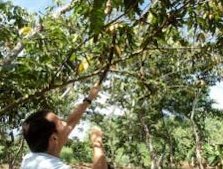 |
 |
| Fig.
3,4. Collecting the seeds, and ripe Inga seeds. |

Fig. 5. Cleaning the seeds by removing the pulp.
The
best method of propagation is using plastic bags 15 cm wide and 20 cm
high, filled with soil. If enough seed is available, two should be
planted in each bag, eliminating the smaller of the two in case both
germinate. Bags should be placed under shade with periodic watering to
maintain the soil humid. Germination will occur in 1-2 weeks. The
plants will be ready for the definitive transplant when 30-40 cm high
after around 3-4 months. During this period, shade must be
progressively eliminated.
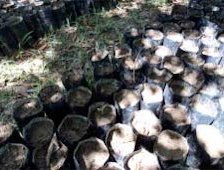 |
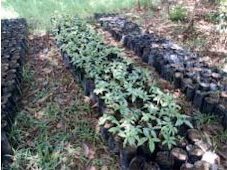 |
Fig.
6,7. Inga seeds germinating in black plastic bags, and young Inga
seedlings in the bags. |
Establishment
and Growth
Once
the plants are ready, whether 30-40 cm high or after 3 months in the
bag, they should be taken to the planting site during the rainy season,
to assure wet soils which augment the possibility of the plants to take
root. If on a slope, a makeshift wood A frame leveling instrument will
be needed to make sure the planting will be in contour. The distance
between rows of plants normally is 4 meters and between plants in the
row, 50 to 100 centimeters. If the latter distance is chosen, costs
will be reduced but later it will be necessary to plant a crop such as
pineapple between each tree in the row to help control erosion. If the
distance is 50cm, then it will suffice to place the thin branches not
used as fuel wood in the spaces between trees to help hold any soil,
which might be eroded, by rains.
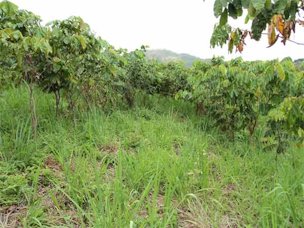
Fig.
8. Rows of Inga growing on either side of the alley.
During
the first year it will be necessary to clear vegetation 3-4 times at
least. If the vegetation is not so thick, than clearing 1 meter around
each plant will do. However, if vegetation is thick, then clearing the
whole area will have to be done. These clearings must be done until the
Inga canopy closes and starts to smother weeds and other vegetation.
This should happen in the second year. However, in some degraded slopes
this process can take up to 3 years.
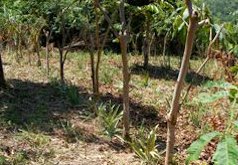 |
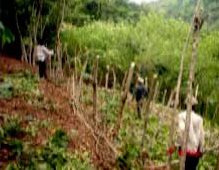 |
Fig.
9,10. Inga planted following the contours with pineapples filling the
gaps and sticks to prevent erosion. |
Intercropping
Once the
canopy has closed, it will need to be pruned for crops to be
planted. The trees are pruned to about chest height. Pruning
too
low could kill the trees. Once the pruning is done, sunlight will be
available for crops to grow and all foliage will be deposited in the
ground between rows. However, in degraded soils where Inga needs more
time to grow, crops can be planted even during the first year when no
pruning is needed, but foliage from legumes will have to be applied as
mulch to decompose so its nutrients are available for the crop. Such
legumes could be Cassia
siamea, Acacia
mangium, Gliricidia sepium or any other plants known to
the locals.
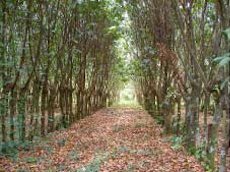 |
 |
Fig.
11,12. Mature alley with closed canopy, and beans planted after the
Inga has been pruned. |
Crops
such as corn can be interplanted within rows (normally 4 meters wide)
at 1 meter between crop rows for a total of three rows of corn in the
alleys. Beans can be planted up to five rows in each Inga alley, while
three rows of pineapples will grow well. Spices such as black pepper
can also be grown within the Inga alleys. Live stakes (tutors) for
support of the pepper plants will be needed and should be planted in
one row in the alleys at 2 meters separation between tutors.
 |
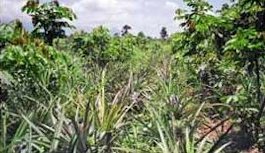 |
Fig.
13, 14. Honduran farmer in tall maize, and pineapples
growing in an Inga alley. |
Once
the Inga has been pruned it will take from 8 to 12 months before it
completely closes again, allowing at least 6 months of sunlight for the
crops, and this will depend on the soil and climate.
In
Honduras, once corn is ready to harvest, it is very common for the
smallholder farmer to bend the stalk because he is usually short of
labor and it is in the rainy season and he cannot harvest in one day,
so this helps avoid the corn catching water and rotting because the
husks will shed rainwater.
Implications
of inga Alley Cropping
In
relation to food security, Inga alley-cropping replaces unsustainable
slash and burn agriculture, resists droughts of up to six weeks,
decreases erosion and landslides, increases productivity and generates
more than 100 % of the fuel wood the farmer needs for cooking from a
not very big plot.
Economically, Inga alley cropping increases
the return rate on investment, minimizes use of external expensive
chemical inputs, liberates land for diversification and competes
favorably with imported grains.
As far as labor is concerned,
Inga alley cropping reduces total days of labor, increases efficiency
and productivity of the land and reduces or eliminates weeding.
The
environment is favored with Inga alley cropping because it increases
water retention in the soil and quality of the same, reestablishes wild
life, and regenerates recycling processes and natural associations. And
where forest is being continuously cleared for new fertile plots to
farm this is no longer necessary as the Inga enables the same plot to
be farmed continuously year after year.
Characteristics
of Inga Alley Cropping
• It is an agroforestry prototype resulting from the combination of
local and scientific knowledge.
• It starts with zero burns.
• It is based on the concept of soil improvement.
• Soil has direct cover from crop residues and biomass from prunings.
• Middle strata are covered with crops.
• Arboreal cover in top strata by Inga planted in contour at 4 meters
between rows.
• More than 12 years of persistency to this date.
• Protects and recovers biodiversity.
• Allows animal use when crop residues provided or forages planted.
• Provides fuel wood for home use and surplus for sale.
• It is an open system that accepts improvement.
Lessons
Learned
• Without food security there is no opening towards resource management
and diversification.
• Participatory processes are an effective way to assure success with
any new technology.
• Zero burning generates demand for new technologic menus.
• Emphasis on adequate soil management makes this system successful.
What do
Producers Say?
• Reduces labor, cost and time.
• Maintains soil humidity, reducing losses from drought for up to six
weeks.
• Produces enough fuel wood.
• One farmer can manage up to 2.0 hectares.
• Allows diversification.
Bibliography
1. Akonde,
T.P., Kuhne, R.F., Steinmuller, N, and Leihner, D.E. 1997,
Alleycropping in an Ultisol in sub-humid Benin. Part 3: Nutrient budget
of maize, cassava and
trees. Agroforestry Systems 27:
213-226
2. (Balligar and Bennett, 1986)
3. CATIE,
OXFORD FORESTRY INSTITUTE & FORESTRY RESEARCH
PROGRAM. 2003 Arboles de Centro America. CATIE,
Turrialba,
Costa Rica.
4. Hands, M.R. 1998 The uses of Inga in
acids soils of the rainforest zone: alleycropping sustainability and
soil regeneration. IN: The genus Inga:
Utilization. Pennington, T.D. & Fernandes, E.C. (eds).
pp 53-86
5. Herrera,
M.A., Salamanca, J. and Barea, J.M. 1993 Mycorrhizal
associations and their functions in nodulating nitrogen-fixing trees.
In: Subba, N.S. and Rodriguez, C. (eds) Symbiosis in nitrogen-fixing
trees. Oxford and IBH Publishing Co. New Delhi, India. pp
141-158
6. Horst,
W.J., Asher, C.J., Szulkiewicz, P., and Wiesemeier,
A. 1992 Short term responses of soybean roots to
aluminum. J.
Plant Physiol. 140: 174-178
7. Pennington, T.D. and Fernandes, E.C.
(eds) 1998 The genus Inga: Utilization.
Continental Printing, Belgium. 167 p.
8. Reynolds
L. and Jabber, M. 1994 The role of alley farming in
African
livestock production. Outlook on Agriculture 23
(2): 105
9. Schoeneberger,
M. 2009 Agroforestry working trees for sequestering carbon on
agricultural lands. Agroforestry Systems 75: 25-37
|
Copyright © Guillermo Valle 2010.
|
Bibliography
Valle, Guillermo. "Inga Alley Cropping Manual." Manual of Inga Agroforestry,
2010, Rainforest Saver,
www.rainforestsaver.org/inga-alley-cropping-manual. Accessed 7 June2020.
Photographs
Fig. 1 Miller, Tiiu. "Young Inga tree." Rainforest Saver,
2009, www.rainforestsaver.org/inga-alley-cropping-manual. Accessed 7
June2020.
Fig. 2 Bityo, Delor. "Inga root nodules." Rainforest Saver,
2010, www.rainforestsaver.org/inga-alley-cropping-manual. Accessed 7
June2020.
Fig. 3,4 Valle, Guillermo. "Collecting
the seeds, and ripe Inga seeds." Rainforest
Saver, 2010,
www.rainforestsaver.org/inga-alley-cropping-manual. Accessed 7 June2020.
Fig. 5 Valle, Guillermo. "Cleaning the seeds by
removing the pulp." Rainforest
Saver, 2010,
www.rainforestsaver.org/inga-alley-cropping-manual. Accessed 7 June2020.
Fig. 6,7 Valle, Guillermo. "Inga seeds
germinating in black plastic bags, and young Inga seedlings in the
bags." Rainforest Saver,
2010, www.rainforestsaver.org/inga-alley-cropping-manual. Accessed 7
June2020.
Fig. 8 Valle, Guillermo. "Rows of Inga
growing on either side of the alley." Rainforest Saver,
2010, www.rainforestsaver.org/inga-alley-cropping-manual. Accessed 7
June2020.
Fig. 9 Miller, Tiiu. "Inga planted following
the contours with pineapples filling the gaps." Rainforest Saver,
2010, www.rainforestsaver.org/inga-alley-cropping-manual. Accessed 7
June2020.
Fig. 10 FUPNAPIB. "Sticks to prevent
erosion." Rainforest
Saver, 2006,
www.rainforestsaver.org/inga-alley-cropping-manual. Accessed 7 June2020.
Fig. 11 Miller, Tiiu. "Mature alley with closed
canopy." Rainforest
Saver, 2009,
www.rainforestsaver.org/inga-alley-cropping-manual. Accessed 7 June2020.
Fig. 12 Valle, Guillermo. "Beans
planted after the Inga has been pruned." Rainforest Saver,
2009, www.rainforestsaver.org/inga-alley-cropping-manual. Accessed 7
June2020.
Fig. 13 Melville, Anthony. "Honduran farmer in
tall maize." Rainforest
Saver, 2007,
www.rainforestsaver.org/inga-alley-cropping-manual. Accessed 7 June2020.
Fig. 14 Valle, Guillermo. "Pineapples growing
in an Inga alley." Rainforest
Saver, 2005,
www.rainforestsaver.org/inga-alley-cropping-manual. Accessed 7 June2020.
Published 3 Nov. 2020 LR
|













